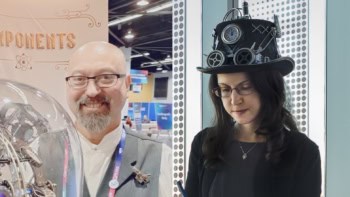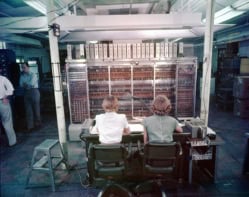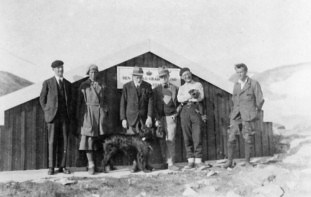What are the challenges and pitfalls of putting science on the stage? Sidney Perkowitz reports from a recent conference that examined the links between scientific subjects and drama

Ham and eggs belong together, no question; and so, with equal assurance, do yin and yang or law and order. But when it comes to pairing science with art, things have become more tricky since Leonardo da Vinci embodied both. Few of us nowadays can achieve this, and it has become harder to emulate Leonardo. Nevertheless, we try, because there is fascination and value in exploring the messages that science and art can exchange with each other. That was one reason I attended a conference called “Theatres of Science: Crossovers and Confluences”, which was held in September at the University of Glamorgan in the UK. A total of 70 delegates attended from the UK and beyond.
I have been to conferences before that combine science with literature or the visual arts, but “Theatres of Science” is the first I know of to celebrate connections between science and the dramatic arts. The conference was organized by Michael Carklin, who – along with his Glamorgan colleagues – accepted presentations from directors, actors, performance artists and dancers as well as from playwrights, scientists, educators and literary scholars. The result was a highly varied meeting. I attended as a physicist who has written plays and performance pieces with scientific themes; I also gave a presentation with the playwright Lauren Gunderson.
The conference was partly a response to the recent artistic and commercial successes of so-called science plays, notably Michael Frayn’s Copenhagen. Not all the delegates agreed that science plays constitute a distinct genre. But putting science into a play does present special opportunities and problems. Recognizing this, Gunderson and I offered the following definition at the conference. A science play is one in which scientists and scientific ideas, ethical issues or interactions with society are important dramatic elements, but where the science is confined to known limits or reasonable projections. (The science in a science-fiction play, in contrast, does not need to be real.)
Stories or lectures
Stage works with scientific elements date back to ancient Greek drama. Some are well known, such as Friedrich Dürrenmatt’s The Physicists and Bertolt Brecht’s Life of Galileo. However, the success of Copenhagen, coupled with today’s growing scientific awareness, has encouraged a recent spate of science plays (see “When science takes to the stage” Physics World November 2002 pp32-33). No single person could attend all the conference sessions or show expertise in all the sciences covered, which ranged from psychology and biomedicine to hard-edged physical science. I attended a cross-section of events, but was especially interested in physical science, and so, it appears, are playwrights. Topics from physics, chemistry and astronomy are popular, especially the seminal ideas of quantum mechanics and chaos theory, possibly because these ideas are broad enough to support a range of dramatic uses.
Scientists might expect a play involving quantum physics to explain the quantum basics, but playwrights want to tell dramatic stories, not offer scientific lectures. If an idea like “chaos” appears, it is likely to be as an organizing scheme that a playwright uses to construct a play, as in Tom Stoppard’s Arcadia. Expanding this theme in his talk “Storytelling in a quantum world”, Jim Maiwurm of the Department of Theater Arts at the State University of New York at Stony Brook noted that whereas religion and mythology once provided significant metaphors for storytelling, now audiences expect science to explain the world. This drives and justifies the metaphorical use of scientific concepts in Copenhagen, Arcadia and other works such as Penny Penniston’s Now Then Again, which draws on the many-worlds hypothesis of quantum theory. Taking this metaphorical approach probably as far as it can go, Zachary Dunbar of Royal Holloway, University of London, presented an elaborate analysis of the role of the chorus in Sophocles’ Oedipus Tyrannus in terms of the late Ilya Priggogine’s ideas about non-equilibrium thermodynamics.
Gunderson’s play Background, part of which was performed at the conference, uses a scientific process as a metaphor in a different way. The play tells of Ralph Alpher, the US physicist whose calculation of the cosmic background radiation preceded its actual discovery by years but who still remains relatively unknown in the physics community. A centrepiece of the play is a scene where time is counted in reverse from the present to the instant of creation in the Big Bang, much as cosmologists work backwards to understand how today’s world arose from the early universe.
Theatrical explanations
Not everyone, however, is ready to abandon the direct educational value of science plays. This was the view expressed in the keynote address by Carl Djerassi – the Stanford University chemist who invented the birth-control pill and who now, having written several plays, describes himself as a playwright. Djerassi focused somewhat narrowly on his own works, but did treat one broad question: how much science can a science play contain and still be a commercial success? Noting that some successful science plays do not display much science, he opined that for a play to become true “science-in-theatre”, it should present science in pedagogical terms. But that approach, says Djerassi, “usually irritates or terrifies theatre professionals”.
A good science play should indeed give the audience an expanded view of science within a dramatic experience, but, along with the professionals, I am wary of too much explanation, which can be the death of drama. Instead, I showed at the conference how I put scientific concepts into theatrical terms.
An example of this comes from my play Friedmann’s Balloon, which was presented in 2002 by Theater Emory in Atlanta. The play relates to events that took place in the 1920s when the Soviet mathematical physicist Alexander Friedmann challenged Einstein’s conclusion from general relativity that the universe is static. Einstein came to accept Friedmann’s result and called his own original conclusion his “biggest blunder”, making Friedmann (and not Einstein) the grandfather of the expanding universe.
In the play, Friedmann’s mathematician friend Lev finds general relativity incomprehensible and challenges Friedmann to explain what it means. Rising to the bait, Friedmann bets Lev 10 rubles that he can do so. He then calls in a Soviet army sergeant and uses the soldier’s experience in making up a barracks cot with a tautly stretched blanket to show how the shape of space-time produces gravity. Lev is convinced, and ruefully pays Friedmann the 10 rubles.
Another example of putting science into a theatrical context is my play Glory Enough, which was also excerpted at the conference. It centres on the work of Rosalind Franklin and examines who should have received proper credit for the discovery of the structure of DNA. By incorporating an edgy discussion between Franklin and her friend Anne, members of the audience are able to grasp how X-rays can probe molecules and why Franklin’s X-ray images were important.
The human angle
The conflict inherent in Franklin’s story is a reminder that an engrossing science play should make us care about people as well as ideas. Human stories were prominent in many works shown at the conference. For example, Gunderson’s Leap – portions of which she presented at the conference – contrasts a young Isaac Newton’s intellectual activities with his human relationships or lack of them by introducing Brightman – a kind of female scientific muse who falls in love with Newton but finds that he does not return the feelings.
Meanwhile, Comet Hunter by Chiori Miyagawa of Bard College in New York focuses on Caroline Herschel – the sister of the 19th-century astronomer William Herschel who discovered the planet Uranus. Although textbooks note only that Caroline contributed to William’s astronomical observations, the play scenes shown at the conference made both Herschels more real by showing their loving brother-sister relationship. It also deepened our sense of Caroline’s place in the all-male scientific world of her time.
In writing Comet Hunter, Miyagawa collaborated with James Lattis, a historian of astronomy at the University of Wisconsin Madison. As the two spoke about their interaction, the scientists and artists began to appreciate each other’s concerns as they connected. Another example of scientists and artists changing each other came from Einstein’s Gift, by Vern Thiessen of the Citadel Theatre in Edmonton, Canada. The play is partly about the chemist Fritz Haber’s Nobel-prize-winning work that established the process of “nitrogen fixing”, which can be used to create ammonia from air and is essential in the production of agricultural fertilizers. In Thiessen’s presentation at the conference, actors playing Haber and his colleagues were taught the chemical basics of the fixing method by Nigel Hodge, who teaches general science at Glamorgan. Armed with this new knowledge, the troupe brought enhanced authority and commitment to the scene where the research team works out the chemical parameters for the process.
Successful mixing
Despite such good interactions, I suspect that many scientists would prefer didactic science on stage, rather than metaphorical and qualitative science. Scientists, it seems to me, want their science to be correct and to be explained correctly. That did not always happen at “Theatres of Science”, where dubious or speculative science was occasionally presented as fact. But while it is essential that accuracy should not be sacrificed, the conference showed me once again that scientists and artists can act as each other’s muses – and that the stimulus provided by a muse should be judged less by some standard of correctness than by the quality of what it inspires.
An example of such inspiration came in the presentation “Choreography and theoretical physics” by dancer Rita Marcalo of University College Chichester. She found that the ideas of the philosopher Henry Bergson and the physicist David Bohm refined her thinking about time and space – not as abstract physical entities but as the medium in which she dances. Bergson’s concept of heterogeneous time validated a new choreographic approach – the creation of works based on memories of previous works. They also influenced her piece Crooked Angels.
Ending this report with the likes of Bergson might suggest a heavily academic conference, but the mix of attendees kept it lively and engaging. Science and art came together in energetic discussions that began at breakfast and continued throughout the day, often into the early morning. And although none of us alone could match Leonardo, he too, I think, would have been a happy delegate.



